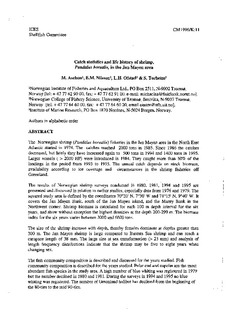| dc.contributor.author | Aschan, Michaela | |
| dc.contributor.author | Nilssen, Einar M. | |
| dc.contributor.author | Ofstad, Lise Helen | |
| dc.contributor.author | Torheim, Sverre | |
| dc.date.accessioned | 2012-09-28T06:56:08Z | |
| dc.date.available | 2012-09-28T06:56:08Z | |
| dc.date.issued | 1996 | |
| dc.identifier.citation | This report is not to be cited without prior reference to the authors | no_NO |
| dc.identifier.uri | http://hdl.handle.net/11250/105631 | |
| dc.description.abstract | The Norwegian shrimp (Pandalus borealis) fisheries in the Jan Mayen area in the North East
Atlantic started in 1974. The catches reached 2000 tons in 1985. Since 1986 the catches
decreased, but lately they have increased again to 500 tons in 1994 and 1400 tons in 1995.
Larger vessels ( > 2000 HP) were introduced in 1984. They caught more than 50% of the
landings in the period from 1993 to 1995. The annual catch depends on stock biomass,
availability according to ice coverage and circumstances in the shrimp fisheries off
Greenland.
The results of Norwegian shrimp surveys conducted in 1980, 1981, 1994 and 1995 are
presented and discussed in relation to earlier studies, especially data from 1976 and 1979. The
squared study area is defined by the coordinates 70°20' N, 7°30' W and 71 °15' N, 9°40' W. It
covers the Jan Mayen Bank, south of the Jan Mayen island, and the Marøy Bank in the
Northwest corner. Shrimp biomass is calculated for each 100 m depth interval for the six
years, and show without exception the highest densities at the depth 200-299 m. The biomass
index for the six years varies between 3000 and 6600 tons.
The size of the shrimp increase with depth, thereby females dominate at depths greater than
300 m. The Jan Mayen shrimp is large compared to Barents Sea shrimp and can reach a
carapace length of 38 mm. The large size at sex transformation (> 23 mm) and analysis of
length frequency distributions indicate that the shrimp may be five to eight years when
changing sex.
The fish community composition is described and discussed for the years studied. Fish
community composition is described for the years studied. Polar cod and capelin are the most
abundant fish species in the study area. A high number of blue whiting was registered in 1979
but the number declined in 1980 and 1981. During the surveys in 1994 and 1995 no blue
whiting was registered. The number of Greenland halibut has declined from the beginning of
the 80-ties to the mid 90-ties. | no_NO |
| dc.language.iso | eng | no_NO |
| dc.publisher | ICES | no_NO |
| dc.relation.ispartofseries | ICES CM Documents;1996/K:11 | |
| dc.subject | shrimps | no_NO |
| dc.subject | reker | no_NO |
| dc.subject | landing | no_NO |
| dc.subject | landet fangst | no_NO |
| dc.subject | fisheries history | no_NO |
| dc.subject | fiskerihistorie | no_NO |
| dc.subject | biomass | no_NO |
| dc.subject | biomasse | no_NO |
| dc.title | Catch statistics and life history of shrimp, Pandalus borealis, in the Jan Mayen area | no_NO |
| dc.type | Working paper | no_NO |
| dc.subject.nsi | VDP::Agriculture and fishery disciplines: 900::Fisheries science: 920::Catch: 925 | no_NO |
| dc.subject.nsi | VDP::Agriculture and fishery disciplines: 900::Fisheries science: 920::Resource biology: 921 | no_NO |
| dc.source.pagenumber | 26 s. | no_NO |
